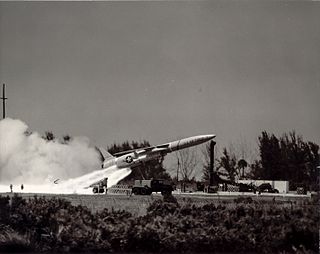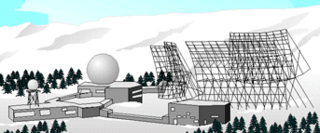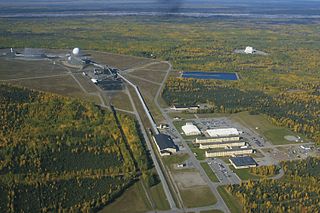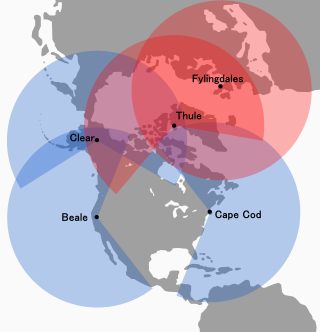The AIM-120 Advanced Medium-Range Air-to-Air Missile(AMRAAM) ( AM-ram) is an American beyond-visual-range air-to-air missile capable of all-weather day-and-night operations. It uses active transmit-receive radar guidance instead of semi-active receive-only radar guidance. When an AMRAAM missile is launched, NATO pilots use the brevity code "Fox Three".

The TomahawkLand Attack Missile (TLAM) is a long-range, all-weather, jet-powered, subsonic cruise missile that is primarily used by the United States Navy and Royal Navy in ship and submarine-based land-attack operations.

PAVE PAWS is a complex Cold War early warning radar and computer system developed in 1980 to "detect and characterize a sea-launched ballistic missile attack against the United States". The first solid-state phased array deployed used a pair of Raytheon AN/FPS-115 phased array radar sets at each site to cover an azimuth angle of 240 degrees. Two sites were deployed in 1980 at the periphery of the contiguous United States, then two more in 1987–95 as part of the United States Space Surveillance Network. One system was sold to Taiwan and is still in service.

The Raytheon Company was a major U.S. defense contractor and industrial corporation with manufacturing concentrations in weapons and military and commercial electronics. It was previously involved in corporate and special-mission aircraft until early 2007. Raytheon was the world's largest producer of guided missiles. In April 2020, the Raytheon Company merged with United Technologies Corporation to form Raytheon Technologies, which changed its name to RTX Corporation in July 2023.

The Hughes Aircraft Company was a major American aerospace and defense contractor founded on February 14, 1934 by Howard Hughes in Glendale, California, as a division of Hughes Tool Company. The company produced the Hughes H-4 Hercules aircraft, the atmospheric entry probe carried by the Galileo spacecraft, and the AIM-4 Falcon guided missile.

The Northrop SM-62 Snark is an early-model intercontinental range ground-launched cruise missile that could carry a W39 thermonuclear warhead. The Snark was deployed by the United States Air Force's Strategic Air Command from 1958 through 1961. It represented an important step in weapons technology during the Cold War. The Snark was named by Jack Northrop and took its name from the author Lewis Carroll's character the "snark". The Snark was the only surface-to-surface cruise missile with such a long range that was ever deployed by the U.S. Air Force. Following the deployment of ICBMs, the Snark was rendered obsolete, and it was removed from deployment in 1961.

The AGM-154 Joint Standoff Weapon (JSOW) is a glide bomb that resulted from a joint venture between the United States Navy and Air Force to deploy a standardized medium range precision guided weapon, especially for engagement of defended targets from outside the range of standard anti-aircraft defenses, thereby increasing aircraft survivability and minimizing friendly losses. It is intended to be used against soft targets such as parked aircraft, trucks, armored personnel carriers (APCs), and surface-to-air missile sites (SAMs). Prior to launch, it is given a destination through either a predesignated waypoint or a point marked through a targeting pod. It glides, using two wings that pop out for added lift, to the marked destination and dispenses submunitions in a short, roughly linear pattern. The designation of the Joint Standoff Weapon as an "air-to-ground missile" is a misnomer, as it is an unpowered bomb with guidance avionics, similar to the older GBU-15.

The RCA 474L Ballistic Missile Early Warning System was a United States Air Force Cold War early warning radar, computer, and communications system, for ballistic missile detection. The network of twelve radars, which was constructed beginning in 1958 and became operational in 1961, was built to detect a mass ballistic missile attack launched on northern approaches [for] 15 to 25 minutes' warning time also provided Project Space Track satellite data.

Clear Space Force Station is a United States Space Force radar station for detecting incoming ICBMs and submarine-launched ballistic missiles to NORAD's command center and to provide Space Surveillance data to the United States Space Force. Clear's AN/FPS-123 Upgraded Early Warning Radar is part of the Solid State Phased Array Radar System (SSPARS) which also includes those at Beale AFB, Cape Cod Space Force Station, RAF Fylingdales and Thule Site J. The "historic property" was one of the Alaska World War II Army Airfields and later a Cold War BMEWS site providing NORAD data to Colorado's BMEWS Central Computer and Display Facility (CC&DF).

Patrick Space Force Base is a United States Space Force installation located between Satellite Beach and Cocoa Beach, in Brevard County, Florida, United States. It is named in honor of Major General Mason Patrick, USAAC. It is home to Space Launch Delta 45, known as the 45th Space Wing (45 SW) when it was part of the Air Force. In addition to its "host wing" responsibilities at Patrick SFB, the 45 SW controls and operates Cape Canaveral Space Force Station (CCSFS) and the Eastern Range. It was originally opened and operated from 1940 to 1947 as Naval Air Station Banana River, a U.S. Navy airfield. It was then deactivated as a naval installation in 1947 and placed in caretaker status until it was transferred to the Air Force in late 1948.

The AN/APG-63 and AN/APG-70 are a family of all-weather multimode radar systems designed by Hughes Aircraft for the F-15 Eagle air superiority fighter. These X band pulse-Doppler radar systems are designed for both air-air and air-ground missions; they are able to look up at high-flying targets and down at low-flying targets without being confused by ground clutter. The systems can detect and track aircraft and small high-speed targets at distances beyond visual range down to close range, and at altitudes down to treetop level. The radar feeds target information into the aircraft's central computer for effective weapons delivery. For close-in dogfights, the radar automatically acquires enemy aircraft and projects this information onto the cockpit head-up display. The name is assigned from the Army Navy Joint Electronics Type Designation System.

The AN/FPS-108 COBRA DANE is a PESA phased array radar installation operated by Raytheon for the United States Space Force at Eareckson Air Station on the island of Shemya, Aleutian Islands, Alaska. The system was built in 1976 and brought online in 1977 for the primary mission of gathering intelligence about Russia's ICBM program in support of verification of the SALT II arms limitation treaty. Its single face 29 m (95 ft) diameter phased array radar antenna 52.7373°N 174.0914°E faces the Kamchatka Peninsula and Russia's Kura Test Range. COBRA DANE operates in the 1215–1400 MHz band and can track items as small as a basketball sized drone at distances of several hundred miles.

The Western Range (WR) is the space launch range that supports the major launch head at Vandenberg Space Force Base. Managed by the Space Launch Delta 30, the WR extends from the West Coast of the United States to 90° East longitude in the Indian Ocean where it meets the Eastern Range Operations involve military, government, and commercial interests. The WR has been operated by civilian contractors since its establishment, following the precedent of the Eastern Range. On 1 October 2003, InDyne Inc. took over the range contract from ITT Industries which had operated the range for the previous 44 years.

The Eastern Range (ER) is an American rocket range (Spaceport) that supports missile and rocket launches from the two major launch heads located at Cape Canaveral Space Force Station and the Kennedy Space Center (KSC), Florida. The range has also supported Ariane launches from the Guiana Space Centre as well as launches from the Wallops Flight Facility and other lead ranges. The range also uses instrumentation operated by NASA at Wallops and KSC.
The Missile Test Project (MTP) was a U.S. Air Force program operated by RCA Service Company (RCAS) from Patrick Air Force Base, Florida, under the direction of prime contractor Pan American Guided Missiles Research Division during the 1950s and continuing on for several more decades. Under this program, RCAS instrumented and operated various ships and stations on the Air Force Eastern Test Range with electronic tracking and telemetry equipment. The instrumented ships and stations tracked incoming intercontinental ballistic missiles launched from Cape Canaveral Air Force Station (CCAFS) and, using radar or telemetry, also tracked crewed or uncrewed space vehicles orbiting the Earth.
Pan American Airways Guided Missile Range Division was a distinct division of Pan American World Airways in the period 1950-1980, responsible as prime contractor of the U.S. Air Force Eastern Test Range, based out of Patrick Air Force Base, Florida. It was responsible for providing operations and maintenance for the Eastern Test Range, but subcontracted operation and maintenance of electronic equipment, such as missile tracking radars on the test range tracking ships and stations to the Missile Test Project of RCA Service Company (RCAS).

The Space Launch Delta 45 is a unit of the United States Space Force. The Space Launch Delta 45 is assigned to Space Systems Command and headquartered at Patrick Space Force Base, Florida. The wing also controls Cape Canaveral Space Force Station. The 45th Space Delta is responsible for all space launch operations from the East Coast. It manages the Eastern Range, including launch activities for the Space Force, Department of Defense (DoD), NASA, and other private space corporations.

The RIM-66 Standard MR (SM-1MR/SM-2MR) is a medium-range surface-to-air missile (SAM), with a secondary role as an anti-ship missile, developed for the United States Navy (USN). A member of the Standard Missile family of weapons, the SM-1 was developed as a replacement for the RIM-2 Terrier and RIM-24 Tartar that were deployed in the 1950s on a variety of USN ships. The RIM-67 Standard (SM-1ER/SM-2ER) is an extended range version of this missile with a solid rocket booster stage.

The Solid State Phased Array Radar System is a United States Space Force radar, computer, and communications system for missile warning and space surveillance. There are SSPARS systems at five sites: Beale Air Force Base, CA, Cape Cod Space Force Station, MA, Clear Space Force Station, AK, RAF Fylingdales, UK, and Pituffik Space Base, Greenland. The system completed replacement of the RCA 474L Ballistic Missile Early Warning System when the last SSPAR was operational at then-Clear Air Force Station in 2001.

RTX Corporation, formerly Raytheon Technologies Corporation, is an American multinational aerospace and defense conglomerate headquartered in Arlington, Virginia. It is one of the largest aerospace and defense manufacturers in the world by revenue and market capitalization, as well as one of the largest providers of intelligence services. In 2023, the company's seat in Forbes Global 2000 was 79. RTX manufactures aircraft engines, avionics, aerostructures, cybersecurity solutions, guided missiles, air defense systems, satellites, and drones. The company is also a large military contractor, getting a significant portion of its revenue from the U.S. government.















